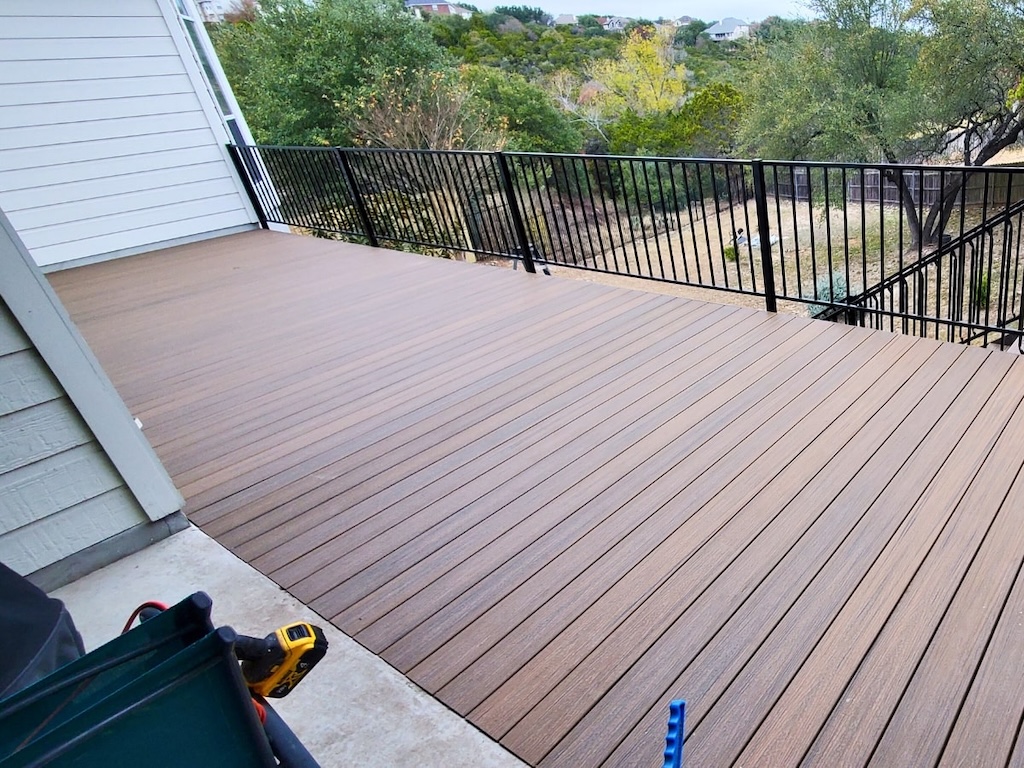TL;DR
Texas decks fail from UV, heat, water, and movement—not just “bad boards.” Choosing the right decking materials is crucial. For maximum durability, combine (1) stable surface materials (PVC or premium capped composites; ipe for natural wood), (2) structure-first detailing (ledger flashing, correct spans, ventilation), (3) corrosion-appropriate hardware, and (4) light colors + shade for cooler temps. Expect the best long-term results from a specialist who provides detailed plans and inspection milestones. If you want to see the level of process and craftsmanship you should expect locally, start with Ace Deck Builders.
Table of Contents
ToggleWhy “Durable” in Texas Means More Than Just the Board

“Durable decking” is a system, not a SKU. The longest-lasting projects in Texas marry the right decking material + the correct details:
- The right material for your sun exposure, water contact, and use pattern.
- Proper structure (footing depth, spans/spacing, ventilation) aligned to manufacturer specs and code.
- Proper hardware that won’t corrode in splash or soil-adjacent zones.
- Right color/texture so the surface runs cooler and avoids heat-driven movement.
If any piece is wrong—say, a great PVC board on a poorly ventilated low deck—durability suffers. The point of this guide is to help you pick a surface and ensure the bones and details match Texas conditions.
The Enemies of Texas Decks (and How to Beat Each One)
1) UV & Heat
- Effect: Fades color, warms surfaces, accelerates expansion/contraction.
- Defense: Light tones, matte/embossed textures, targeted shade, gapping per spec, ventilated skirting.
2) Sudden Storms & Water
- Effect: Intrusion at the ledger; swelling at edges; hardware corrosion; trapped moisture under low decks.
- Defense: Proper WRB-integrated ledger flashing, post bases above grade, joist tape where warranted, breathable skirting, drainage paths away from the house.
3) Soil & Movement
- Effect: Heave/settlement that stresses connections; loose rail posts; stair drift.
- Defense: Footing depth/diameter sized for load and soil; inspector-visible footing checks; bracing; correctly blocked rail posts.
4) Human Use & Wear
- Effect: High-traffic scuffing; hot rail caps; stair treads are slick when wet.
- Defense: Textured surfaces, grippable stair finishes, light-tone rail caps, replaceable rail infill when fashion changes.
Defeat the physics, and almost any quality board family can live a long, low-drama life.
The Materials Shortlist: Pros, Cons, Best Fits
PVC (Capped Cellular / All-PVC)
Why it’s durable: Excellent moisture resistance and color stability; many lines are dimensionally steady when installed to spec.
Pros: Minimal ongoing maintenance; strong stain resistance; lighter boards can feel cooler.
Cons: Highest upfront cost; must respect edge support, gapping, and ventilation; darker tones can still run warm.
Best for: Poolside or high-irrigation zones; homes prioritizing a decade-long appearance with minimal upkeep; and mixed sun exposures where color stability matters—these are often the best decking materials .
Premium Capped Composites
Why it’s durable: A hardened cap over a composite core delivers color/UV protection plus dent resistance.
Pros: Wide style range; hidden fasteners/plug systems; predictable maintenance.
Cons: Dark colors can be hot; installation details (gaps/airflow) are non-negotiable for warranty and stability.
Best for: High-use family decks that want the “rinse and relax” routine with lots of color/texture options.
Tropical Hardwoods (Ipe, Cumaru)
Why it’s durable: Extreme density and wear resistance—if detailed correctly.
Pros: Long service life; premium look; strong under foot traffic.
Cons: Higher cost and labor; pre-drilling needed; periodic oiling if you want the rich color (or let it silver naturally).
Best for: Showcase decks, elevated structures that benefit from mass/stiffness, owners comfortable with occasional oiling or natural patina.
Western Red Cedar
Why it’s durable (with care): Naturally rot-resistant and cool underfoot, but relies on finish discipline.
Pros: Beautiful grain; lighter temps; easy to work.
Cons: Needs clean + stain/seal cycles (12–24 months by exposure); softer surface.
Best for: Shaded or morning-sun decks where owners will keep a finish schedule—and want a warm, natural look.
Pressure-Treated Pine (Southern Yellow Pine)
Why it’s durable (for the price): Treatment helps resist insects/rot; detailing and maintenance are key.
Pros: Lowest upfront; easy to customize; repair-friendly.
Cons: Checking/splinters if neglected; finish cycles required; careful hardware selection to avoid reactions.
Best for: Budget-sensitive projects that commit to a realistic maintenance plan and ventilated design.
Aluminum & Hybrid Surfaces
Why consider: Niche but tough—aluminum stays flat and sheds water; some hybrids pair stone/composite caps for specific zones.
Pros: Dimensional stability; low maintenance; excellent water management with systems.
Cons: Aesthetic fit is case-by-case; cost and acoustics can be considerations.
Best for: Specialty applications (rooftop walk decks, heavy water exposure, commercial-grade durability).
Structure, Not Just Surface: Where Longevity Is Won

The same board can last wildly different lengths based on what’s underneath:
- Footings & Posts: Depth/diameter sized to loads; post bases elevated above grade; no posts set directly in soil.
- Ledger & Flashing: Continuous flashing integrated with the home’s weather barrier; fastener pattern per engineering; membranes at critical interfaces where specified.
- Spans & Joist Spacing: Match your chosen board’s table. PVC/composites often want tighter spacing than wood (especially at diagonal patterns).
- Ventilation: Low decks need moving air. Use vented skirting, leave required clearances, and avoid boxing in corners.
- Joist Protection (where appropriate): Tapes or sealants at the tops/end cuts help extend longevity—especially under synthetic boards that retain water longer after rain.
- Rail Post Blocking: Through-bolted, properly blocked to resist racking; stair stringers reinforced and consistent.
- Drainage Paths: Borders and fascia details should steer runoff away from door thresholds and prevent splashback along siding.
A specialist should show these details in a plan set. If you don’t see them, durability is a hope, not a plan.
Color, Texture, and Heat: Comfort Drives Durability
Durability isn’t only “how long until it rots.” It’s also how often you choose to use and maintain it:
- Light tones absorb less heat, which can reduce thermal movement and make summer maintenance (and living) easier.
- Matte, embossed textures feel better underfoot and hide dust/pollen.
- Targeted shade (compact pergola/sail over seating) adds usable hours every week and reduces surface abuse from peak sun.
- Picture-frame borders & divider boards manage expansion/contraction on long runs and keep gaps consistent.
Choose the comfort spec you’ll actually enjoy; owners who love walking on their deck keep it cleaner and catch minor issues early.
Railings, Stairs, and Fasteners: The Hidden Failure Points
Most “my deck feels tired” complaints trace to these parts:
- Rails: Wobbly posts are caused by under-blocked connections or incorrect hardware. Durability requires proper blocking, through-bolting, and adherence to post-to-framing details.
- Stairs: Uneven rise/run, soft stringer cuts, and loose handrails age poorly. Use graspable handrails and properly support landings.
- Fasteners & Hardware: Pair metals to the environment—stainless near pools and heavy irrigation, hot-dipped or coated elsewhere per spec. Don’t mix incompatible metals. Hidden fasteners and plug systems on synthetics protect caps and improve feel.
- Fascia & Skirting: Solid wraps without ventilation trap heat and moisture; step them back or vent them generously.
Durability ratings on boards won’t save a deck with weak connections. Inspectors look for this—so should you.
10-Year Durability Playbook (Copy/Paste)
Before You Build
- Pick one primary surface (PVC, premium composite, or ipe) + one alternate in a light tone.
- Approve a plan set showing ledger flashing, joist spacing, rail post blocking, stair details, and vented skirting.
- Confirm hardware (stainless vs. coated) based on proximity to water/chemicals.
- Align dimensions to 12-, 16-, or 20-ft board lengths; add divider boards on long runs.
During Construction
- Schedule inspection hold points: footing → framing → final.
- Expose connections for framing inspection (don’t bury with decking early).
- Verify that gapping & ventilation meet the board’s warranty requirements.
- Photograph details (ledger, posts, rail blocking) for your records.
After Move-In
- Rinse quarterly; gentle soap scrub as needed (synthetics).
- For wood: set calendar reminders for clean + stain/seal (12–24 months by exposure).
- Keep vent openings clear; trim plants back; don’t lean solid storage against vented skirting.
- Inspect rail posts and stair fasteners annually and tighten as needed.
- Refresh caulk/sealant at house interfaces as part of home maintenance.
Where to See a Texas-Ready Process (mid-read benchmarks)

If you’re comparing options and want to visualize the structural sequence, it helps to skim a specialist’s overview of deck installation in Austin for drawings, inspection gates, and closeout practices. If your existing structure is aging or undersized and you want apples-to-apples pricing for a complete refresh, glance through deck replacement in Austin to see how demo, footings, framing, and finish materials come together in a rebuild. And if you’d like a broader primer before choosing your lane, this homeowner’s guide to the best types of deck materials lays out categories, textures, and long-term care in plain English.
FAQs
For low-maintenance longevity, the best decking options include PVC and premium capped composites in lighter tones. For natural wood, ipe is the durability leader when properly detailed and maintained.
Yes—lower surface temperatures can reduce thermal movement and make routine care easier, thereby indirectly extending life.
Not if you love the look and commit to a finish schedule. It’s cooler underfoot and beautiful—don’t skip stain/seal cycles.
Only if the frame meets current span/spacing tables, has a properly flashed ledger, and the footings/posts are sound, including the use of pressure treated lumber . Otherwise, new boards over weak bones won’t deliver durability.
Favor stainless fasteners and hardware in splash/chemical zones, and follow the board manufacturer’s requirements for hidden fasteners/plug systems.
Get a Texas-Tough Deck Plan (Free Estimate)
Want an itemized, inspection-ready plan that pairs the right surface (PVC, premium composite, or hardwood) with Texas-smart structure (flashing, spans, ventilation, hardware)—plus a clear schedule and options pricing? Start with a free deck estimate in Austin, and we’ll map sun exposure, bring samples for heat testing, and deliver a decade-proof plan you can trust.
